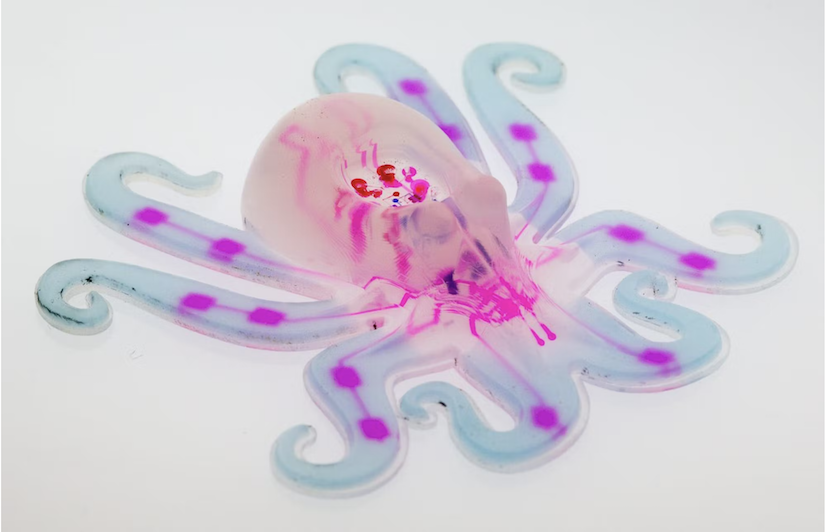For anyone who has ever suffered a back injury while lifting something heavy, Michael Wehner’s research offers an exciting preview of a future where robots could assist humans with such tasks by helping carry the load, literally.
For his PhD dissertation at the University of California at Berkeley, Wehner developed a lower-extremity exoskeleton to assist people with lifting objects. He showed that the exoskeleton—a wearable robot—was able to reduce strain on users’ back muscles while they lifted boxes. Wehner says this technology could one day help reduce on-the-job injuries for warehouse workers.
Wehner’s research focuses on understanding how robots interact with their environment, including with humans. Ultimately, his goal is to devise ways for robots to interact with people safely and effectively.
 The octobot, an entirely soft robot. Credit: Harvard John A. Paulson School of Engineering and Applied Sciences.
The octobot, an entirely soft robot. Credit: Harvard John A. Paulson School of Engineering and Applied Sciences.
“To take the field of robotics to the next level of progress, we need to get robots and people to cooperate with each other,” says Wehner, who joined the UW-Madison Department of Mechanical Engineering as an assistant professor in January 2022. “There is fundamentally a mismatch between the way robots behave and the way humans work. If you want a robot around people, the solution so far has been to make it small or slow, like a Roomba vacuum. I believe there is a lot of opportunity to create alternative methods for human-machine interaction to make inherently safe systems.”
Wehner is particularly interested in the emerging field of soft robotics. Unlike their rigid counterparts, soft robots are built out of elastomers, or rubbery materials, which allow them to bend, twist and change shape. These characteristics enable soft robots to interact much more seamlessly with their environment than traditional robots, making them useful for new applications. In the future, soft robots could assist with surgeries or help patients with rehabilitation after an injury, among other applications.
After earning his PhD, Wehner worked as a postdoctoral fellow at Harvard University, where he made key contributions to several major breakthroughs in soft robotics. He helped invent the first soft exosuit—a soft wearable robot that, in this case, helped increase the wearer’s endurance while walking. The low-profile exosuit actuated the wearer’s legs, providing extra support to the muscles as they moved.
“This technology has applications for the military, where it could give soldiers wearing the exosuit a little boost to push them forward as they walk, helping to reduce their fatigue,” Wehner says. “Assistive exosuits also have the potential to help patients suffering from stroke and multiple sclerosis to regain mobility.”
Then Wehner and his Harvard colleagues broke new ground in 2016 by creating the first autonomous, untethered, entirely soft robot–dubbed the octobot. The octopus-inspired robot had no electronics and was instead powered by chemical reactions controlled by microfluidics. Wehner was co-first author of the paper describing the octobot, which was published in the journal Nature on Aug 25, 2016, and garnered widespread media coverage.
Prior to joining UW-Madison, Wehner was an assistant professor in electrical and computer engineering at the University of California-Santa Cruz. He says UW-Madison’s outstanding reputation for research and education attracted him to the university.
“I’m really excited about all the potential for collaboration at UW-Madison,” he says. “With the expertise and resources at this university, there are excellent opportunities to really make an impact through research and education.”